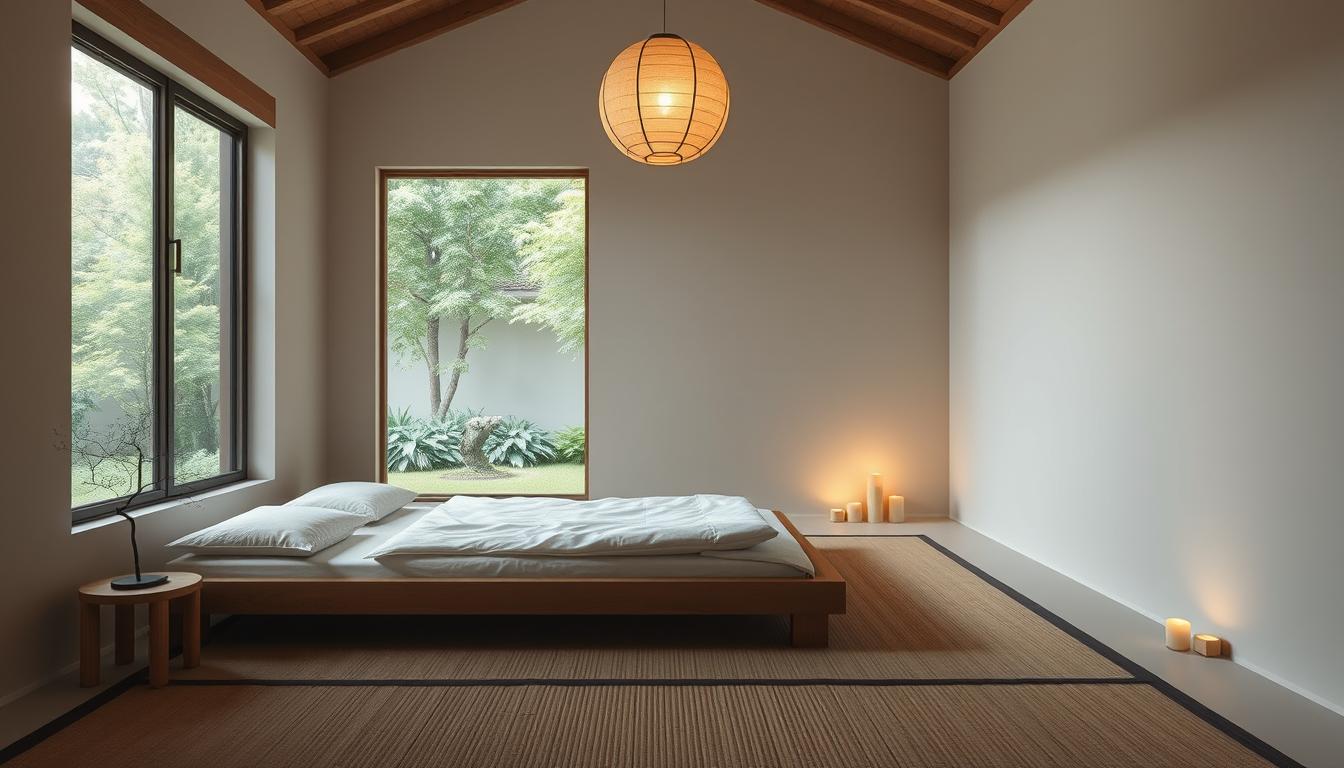Modern life can feel overwhelming, but your home can become a sanctuary of calm. More people are turning to mindful interior design to create peaceful spaces that combat stress. Inspired by Japanese traditions, this approach blends simplicity with modern living.
Research shows that well-designed spaces improve mental clarity and sleep quality. Experts like Julian Daizan highlight how intentional design boosts energy and focus. Even House Beautiful notes the link between thoughtful layouts and happiness.
This isn’t just about looks—it’s a lifestyle shift. By reducing clutter and embracing balance, you invite tranquility into daily life. Ready to explore how small changes can make a big difference?
Key Takeaways
- Mindful design transforms homes into calming retreats.
- Japanese-inspired simplicity reduces daily stress.
- Studies connect peaceful spaces to better sleep and focus.
- Clutter-free layouts enhance mental clarity.
- Small changes create lasting lifestyle benefits.
What Is a Zen House Aesthetic?
Japanese monks first perfected spaces designed for mindfulness. Their principles—honed over centuries—blend function with serenity. Today, these ideas inspire homes worldwide, merging tradition with modern design.
Roots in Zen Buddhism and Japanese Tradition
In 12th-century Japan, Zen Buddhism shaped architecture. Sliding doors (shōji) maximized natural light, while tatami mats created flexible floors. Rock gardens mirrored meditation’s quiet focus.
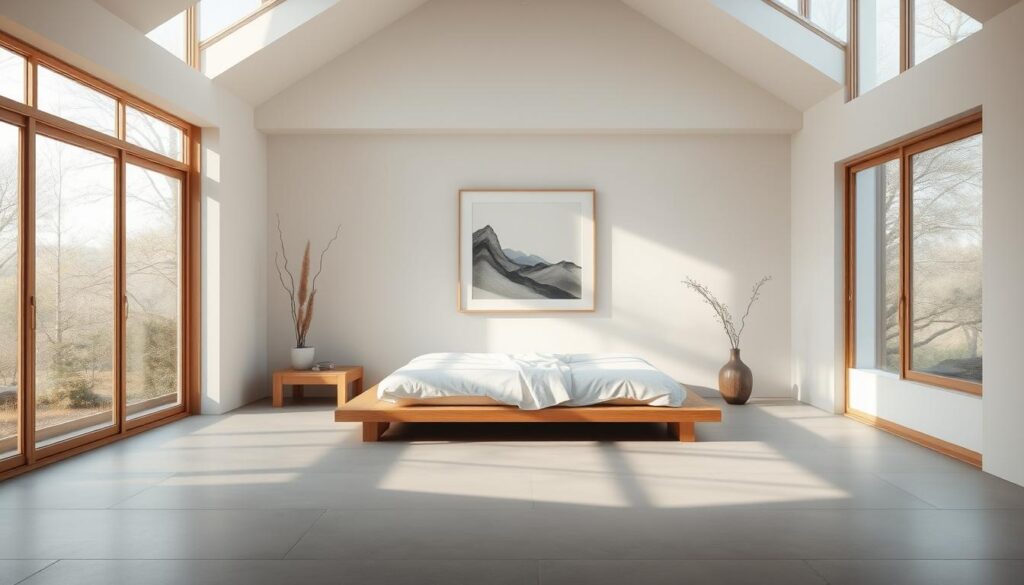
- Tatami mats: Woven straw for adaptable spaces.
- Shōji screens: Paper panels for soft, diffused light.
- Minimal decor: Only essential items to avoid clutter.
Modern Interpretations for Contemporary Homes
Today’s design keeps the spirit but adapts the form. Open floor plans replace monastic layouts. Multifunctional furniture, like IKEA’s Sinnerlig lamp, echoes simplicity.
The wabi-sabi philosophy celebrates imperfections. Think visible wood grain or upcycled natural materials. Even Muji’s bamboo organizers follow this ethos.
Feng shui aligns with Zen, too. Both prioritize energy flow. For example, placing a bed facing east improves sleep—a nod to ancient principles.
Zen House Aesthetic Benefits for Mind and Body
A calm environment isn’t just beautiful—it’s scientifically restorative. Studies reveal how intentional design choices lower stress and boost mental clarity. Here’s how minimalist spaces create a sense peace that benefits your health.
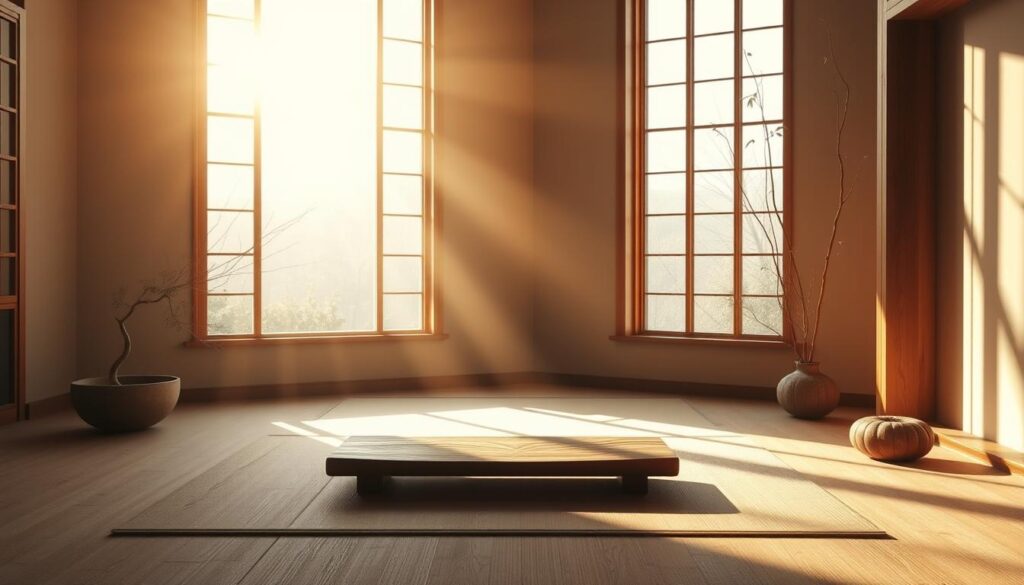
Reducing Stress Through Minimalism
Clutter triggers cortisol, the stress hormone. Research shows decluttering cuts cortisol levels by 27%. Streamlined spaces—like capsule wardrobes or open kitchens—reduce decision fatigue.
- Neutral palettes: Earthborn paints soften visual noise.
- Multifunctional furniture: IKEA’s modular designs maximize simplicity.
Enhancing Focus and Mental Clarity
Natural light aligns with circadian rhythms, sharpening focus. Zenways’ studies highlight how meditation corners improve concentration. Bamboo flooring adds tactile grounding for mindfulness.
Promoting Better Sleep and Relaxation
Low-profile beds and warm lighting signal rest. Third Source data links these elements to 20% deeper sleep. Serotonin levels rise in tranquility-focused rooms.
“Lighting dictates mood. Soft amber hues mimic sunset, preparing the brain for rest.”
Core Principles of Zen Interior Design
The art of mindful living starts with thoughtful design. Rooted in Japanese philosophy, Zen interiors blend simplicity, balance, and a deep connection to nature. These principles transform chaotic spaces into serene retreats.
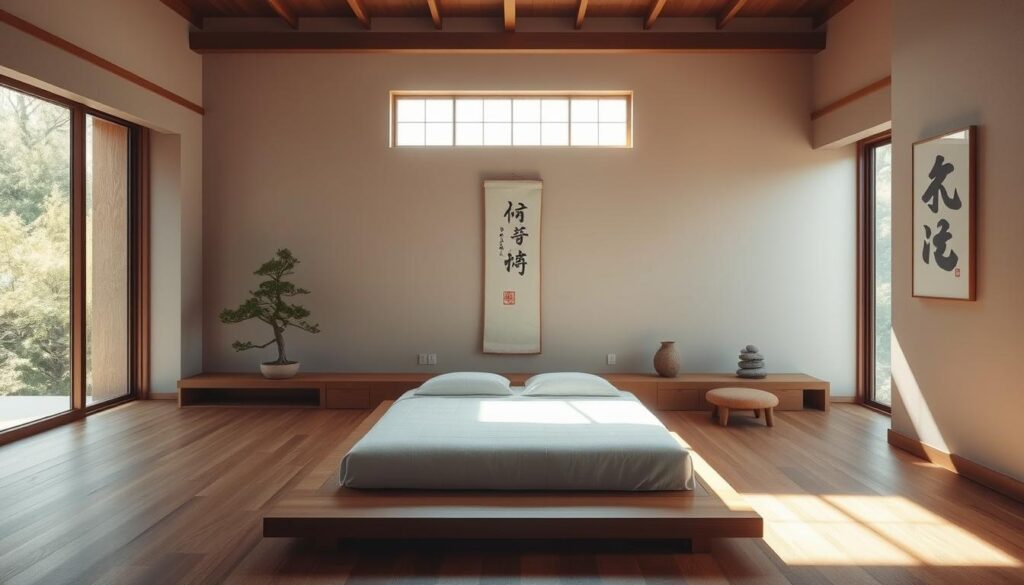
Simplicity: Less Is More
The principle of kanso (simplicity) means removing distractions. Try the 20/20 rule: if you can replace an item for under $20 in 20 minutes, let it go. This creates airy, clutter-free rooms.
Neutral palettes and multifunctional furniture enhance simplicity. Think clean lines and hidden storage, like IKEA’s modular shelves.
Harmony: Balancing Elements Naturally
Fukinsei (asymmetry) celebrates imperfect balance. Place a single off-center plant or artwork to create visual interest. This mirrors nature, where nothing is perfectly symmetrical.
| Zen Design | Scandinavian Minimalism |
|---|---|
| Warm earth tones | Cool whites and grays |
| Organic textures (wood, stone) | Hyggе-inspired textiles |
| Asymmetrical layouts | Symmetrical arrangements |
Connection to Nature: Bringing the Outdoors In
Use natural elements like bamboo flooring or indoor water features. Studies show these improve air quality and mood. Reclaimed wood adds warmth, while stone accents ground the space.
For a tactile touch, try natural materials like jute rugs or clay pots. They bridge indoor and outdoor living seamlessly.
“A room should feel like a breath of fresh air—uncluttered, balanced, and alive.”
How to Create a Zen-Inspired Home: Room-by-Room Guide
Transform each room into a peaceful retreat with intentional design choices. From fluid living areas to restful bedrooms, every space can reflect balance. Here’s how to harmonize functionality and calm.
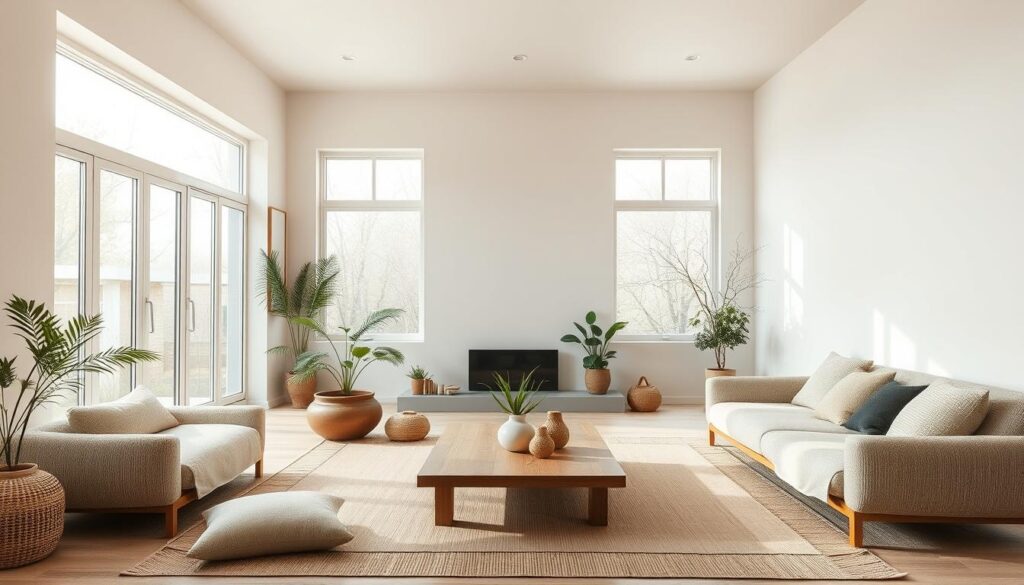
Living Room: Open Spaces and Neutral Textures
Start with Rothko-inspired art and Bali rattan chairs for organic warmth. Modular sofas and hemp rugs create flexible spaces that adapt to your needs. Keep lines clean and colors muted—think beige or soft gray.
- Lighting: Layer floor lamps with dimmers for adjustable ambiance.
- Textures: Jute rugs and linen curtains add tactile depth.
Bedroom: Low-Profile Furniture and Soft Lighting
Platform beds with built-in storage (like The Futon Company’s designs) maximize space. Opt for amber-toned bulbs to mimic sunset, signaling rest. A single potted plant, like a snake plant, purifies air subtly.
“Your bedroom should whisper relaxation—no bright colors or bulky furniture.”
Home Office: Clutter-Free Productivity
A bamboo desk paired with cable organizers keeps distractions minimal. Position your chair facing a window for natural light. Add reclaimed wood accents to ground the elements.
Bathroom: Spa-Like Serenity
Natural stone showers and pebble flooring evoke luxury. Slate trays and eucalyptus showers turn daily routines into rituals. For budget swaps, try natural materials like woven baskets.
- Storage: IKEA’s bamboo organizers hide toiletries neatly.
- Lighting: Frosted sconces diffuse light softly.
Choosing the Right Materials and Colors
The foundation of a calming space lies in thoughtful material and color choices. Whether it’s bamboo flooring or clay-based paint, each element sets the tone for tranquility. Let’s explore how to blend sustainability with style.
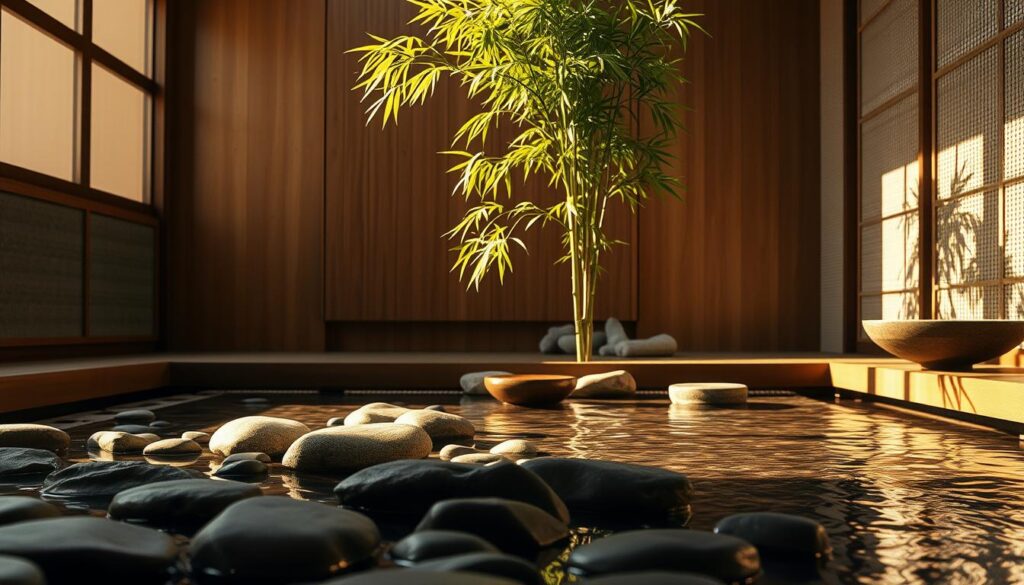
Natural Materials: Wood, Bamboo, and Stone
Bamboo stands out for its eco-friendly perks—it grows 30 times faster than oak. Its durability rivals teak, making it ideal for high-traffic areas. Pair it with reclaimed wood accents for warmth.
For a grounded feel, stone tiles or pebble finishes add texture. Avoid glossy surfaces; matte textures align better with minimalist materials.
Neutral Color Palettes: Beige, White, and Earthy Tones
Layer colors like beige walls with moss green throw pillows. Earthborn’s clay paints add subtle depth. Cream linens and slate gray decor complete the look.
“Neutrals aren’t boring—they’re a canvas for calm.”
Lighting: Maximizing Natural and Ambient Light
Dimmable LED strips and rice paper lanterns soften harsh light. Position mirrors to reflect windows, amplifying natural lighting. For vertical greenery, Heal’s Morvah planters add life without clutter.
- Warm bulbs (2700K) mimic sunset hues.
- Frosted glass diffuses light evenly.
Zen vs. Other Design Styles: What Sets It Apart?
Not all minimalist spaces are created equal—Zen adds intentional depth. While popular design trends focus on looks or comfort, this philosophy prioritizes spiritual clarity. From materials to layouts, every choice serves mindfulness.
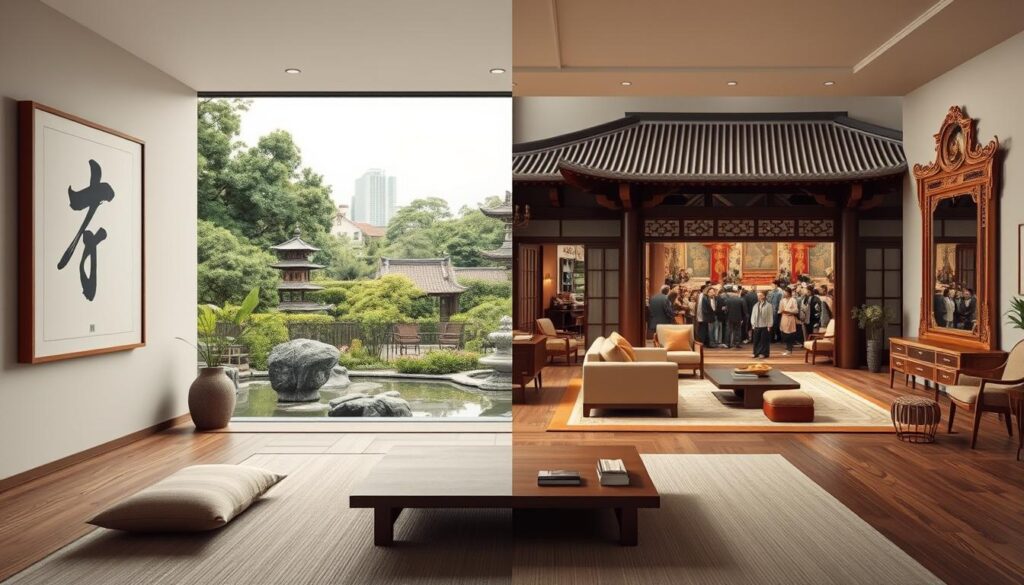
Zen and Scandinavian Minimalism
Scandinavian minimalism embraces hygge—think plush sofas and sheepskin rugs. In contrast, Zen interiors favor floor seating and unadorned surfaces. Both value simplicity, but their purposes differ.
- Materials: Zen uses stone and bamboo; Scandinavia prefers light woods and metals
- Lighting: Candles create hygge warmth vs. Zen’s diffused natural light
- Layouts: Symmetry rules Nordic spaces, while Zen celebrates asymmetry
Zen and Bohemian Eclecticism
Bohemian design thrives on bold patterns and layered textures. Zen avoids this visual noise, opting for clean-lined basketry and monochrome palettes. Both connect to nature, but differently.
“Zen isn’t about filling space—it’s about creating room for thought.”
Globally inspired macramé defines boho aesthetic, whereas Zen might use a single woven tray. Industrial styles favor exposed pipes; Zen chooses flowing water features. Each philosophy shapes interiors uniquely.
Incorporating Zen Practices Into Daily Life
Creating peace at home goes beyond design—it’s about daily rituals. Small, intentional habits amplify the calm of your space. From morning routines to evening wind-downs, mindfulness turns theory into lived serenity.
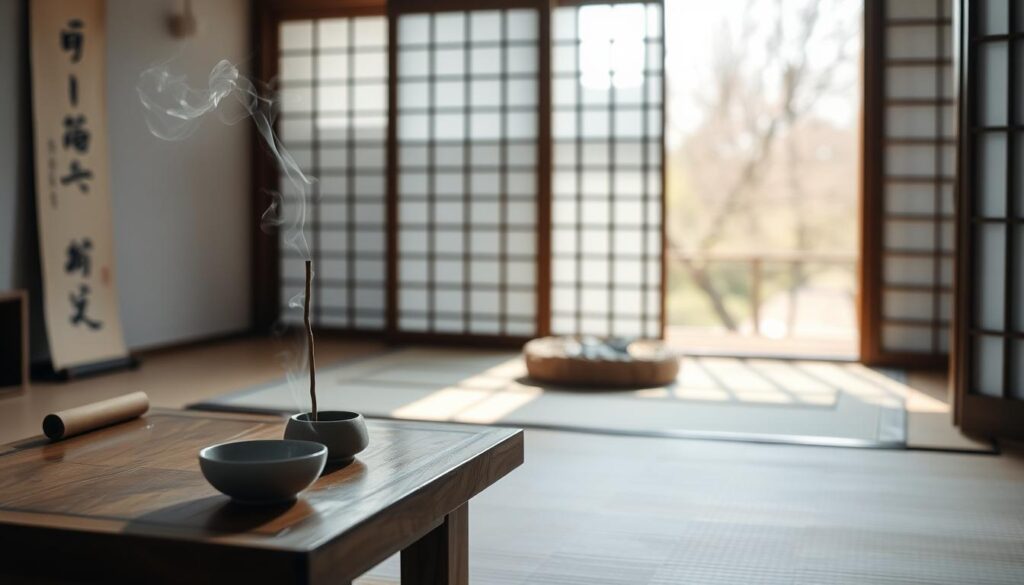
Mindful Decorating: Intentional Choices
Every object should serve purpose or joy. Start with a 5-minute daily scan—remove one item that no longer fits. This habit keeps clutter at bay and sharpens your sense peace.
Introduce elements like kintsugi-repaired ceramics. Their golden seams celebrate imperfections, reminding us of resilience. Pair them with air-purifying plants, such as snake plants, for subtle vitality.
| Mindful Habit | Conventional Alternative |
|---|---|
| Digital detox zones (no screens after 8 PM) | Scrolling in bed |
| Enso circle painting for focus | Binge-watching TV |
| Gratitude journaling by Kim Bennett | Unstructured downtime |
Daily Rituals for a Peaceful Home
Morning meditation with Vectis Karma incense sets a grounded tone. Evening tea in handmade cups turns sips into pauses. These acts anchor the day in mindfulness.
Designate a corner for art therapy—a sketchpad or clay for tactile creativity. As Serenity Retreat’s Kim Bennett notes, “Gratitude journals reframe daily chaos into calm.”
“Rituals are the quiet glue holding tranquility together—simple, repeated, sacred.”
Conclusion: Embrace the Zen House Aesthetic for a Calmer Life
Small changes in your space can spark big shifts in daily calm. A zen-inspired home reduces stress, sharpens focus, and improves sleep—no overhaul needed. Start with one room: swap bright lights for warm bulbs or add a bamboo tray to declutter.
Affordable touches like linen throws or a meditation corner (Zenways’ courses) weave mindfulness into routines. As Jane Alexander notes, “Zen is the perfect tool for modern life.”
Remember, design for tranquility isn’t about perfection. It’s about creating room to breathe. Your sanctuary awaits—one intentional change at a time.

